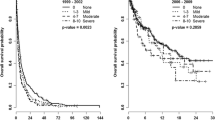Abstract
Dyspnea, which has been defined as an "uncomfortable awareness of breathing," is a frequent and devastating symptom in advanced cancer patients. It has been reported to occur in 21–79% of patients evaluated a few days or weeks before death. In advanced cancer, the aim of effective management is to minimize the patient's perception of breathlessness, which depends in turn on a reliable assessment. Unfortunately, most of our knowledge and experience of dyspnea has been acquired through working with patients with chronic pulmonary disease, and there is a dearth of literature relating specifically to the assessment of dyspnea in advanced cancer. Dyspnea is a complex sensation including several dimensions, such as antecedents (physiological and psychological events or stimuli preceding the development of dyspnea), mediators (characteristics of individuals or their environment affecting the response), reactions to dyspnea, and consequences or outcomes that result once the individual has reacted to a stimulus. The literature gives us many tools to measure these aspects. For example, antecedents may be assessed by the British Medical Research Council Questionnaire, the American Thoracic Questionnaire (ATS-DLD-78) and the Dyspnea Interview Schedule. Mediators of dyspnea may be measured by the ATS-DLD-78, the Chronic Respiratory Questionnaire (CRQ), the Dyspnea Interview Schedule, the Pulmonary Functional Status Scale (PFSS) and the Therapy Impact Questionnaire (TIQ). Reactions to dyspnea may be assessed by the Dyspnea Visual Analogue Scale (DVAS), the TIQ and the Borg Scale, and the consequences of it by the TIQ, the Baseline Dyspnea Index (BDI), the Transition Dyspnea Index (TDI), and CRQ, and by the Oxygen Cost Diagram (OCD), the Dyspnea Interview Schedule and the Modified Medical Research Council Dyspnea Scale (MRC). No single assessment tool considers all the different components of dyspnea, and the final choice will depend on the purpose of the assessment, taking into account that the provision of quality of life is of paramount importance to patients who have limited time left to them and that the assessment should not therefore detract from the quality of life by being overlong, complicated or invasive.
Similar content being viewed by others
Author information
Authors and Affiliations
Rights and permissions
About this article
Cite this article
Mancini, I., Body, J. Assessment of dyspnea in advanced cancer patients. Support Care Cancer 7, 229–232 (1999). https://doi.org/10.1007/s005200050254
Issue Date:
DOI: https://doi.org/10.1007/s005200050254




